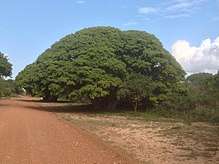Dialioideae
The subfamily Dialioideae is one of the subdivisions of the plant family Fabaceae (legumes). This subfamily includes many tropical trees and shrubs. The subfamily consists of 17 genera, which are widespread throughout the tropics. It has the following clade-based definition:
The most inclusive crown clade containing Poeppigia procera C.Presland Dialium guianense (Aubl.) Sandwith, but not Cercis canadensis L., Duparquetia orchidacea Baill., or Bobgunnia fistuloides (Harms) J. H. Kirkbr. & Wiersema[1]
| Dialioideae | |
|---|---|
 | |
| Dialium schlechteri Harms | |
| Scientific classification | |
| Kingdom: | Plantae |
| Clade: | Tracheophytes |
| Clade: | Angiosperms |
| Clade: | Eudicots |
| Clade: | Rosids |
| Order: | Fabales |
| Family: | Fabaceae |
| Subfamily: | Dialioideae Legume Phylogeny Working Group[1] |
| Type genus | |
| Dialium L. | |
| Genera | |
|
See text | |
| Synonyms | |
| |
Members of the family also share the following morphological characteristics: the presence of cymose inflorescences, the absence of vestured pits in the xylem, and a high degree of organ loss.[2][3]
Taxonomy
Dialioideae comprises the following genera:[1]
- Androcalymma Dwyer
- Apuleia Mart.
- Baudouinia Baill.
- Dialium L.
- Dicorynia Benth.
- Distemonanthus Benth.
- Eligmocarpus Capuron
- Kalappia Kosterm.
- Koompassia Maingay ex Benth.
- Labichea Gaudich. ex DC.
- Martiodendron Gleason
- Mendoravia Capuron
- Petalostylis R.Br.
- Poeppigia C.Presl
- Storckiella Seem
- Uittienia Steenis
- Zenia Chun
Phylogenetics
Dialioideae exhibits the following phylogenetic relationships:[4] (compare [2][5][6][7])
| Fabales |
| ||||||||||||||||||||||||||||||||||||||||||||||||||||||||||||||||||||||||||||||||||||||||||
References
- The Legume Phylogeny Working Group (LPWG). (2017). "A new subfamily classification of the Leguminosae based on a taxonomically comprehensive phylogeny". Taxon. 66 (1): 44–77. doi:10.12705/661.3.
- Herendeen PS, Bruneau A, Lewis GP (2003). "Phylogenetic relationships in Caesalpinioid legumes: A preliminary analysis based on morphological and molecular data". In Klitgaard BB, Bruneau A (eds.). Advances in Legume Systematics, Part 10: Higher Level Systematics. Royal Botanic Gardens, Kew. pp. 37–62. ISBN 9781842460542.
- Zimmerman E, Prenner G, Bruneau A (2013). "Floral ontogeny in Dialiinae (Caesalpinioideae: Cassieae), a study in organ loss and instability". South African Journal of Botany. 89: 188–209. doi:10.1016/j.sajb.2013.06.020.
- Zimmerman E. (2014). Systematics and floral evolution of the Dialiinae (Caesalpinioideae), a diverse lineage of tropical legumes (Ph.D). Papyrus: Institutional Repository, Université de Montréal. hdl:1866/11208.
- Bruneau A, Forest F, Herendeen PS, Klitgaard BB, Lewis GP (2001). "Phylogenetic Relationships in the Caesalpinioideae (Leguminosae) as Inferred from Chloroplast trnL Intron Sequences". Syst Bot. 26 (3): 487–514. doi:10.1043/0363-6445-26.3.487 (inactive 2020-05-21).
- Bruneau A, Mercure M, Lewis GP, Herendeen PS (2008). "Phylogenetic patterns and diversification in the caesalpinioid legumes". Botany. 86 (7): 697–718. doi:10.1139/B08-058.
- Manzanilla V, Bruneau A (2012). "Phylogeny reconstruction in the Caesalpinieae grade (Leguminosae) based on duplicated copies of the sucrose synthase gene and plastid markers". Molecular Phylogenetics and Evolution. 65 (1): 149–162. doi:10.1016/j.ympev.2012.05.035. PMID 22699157.